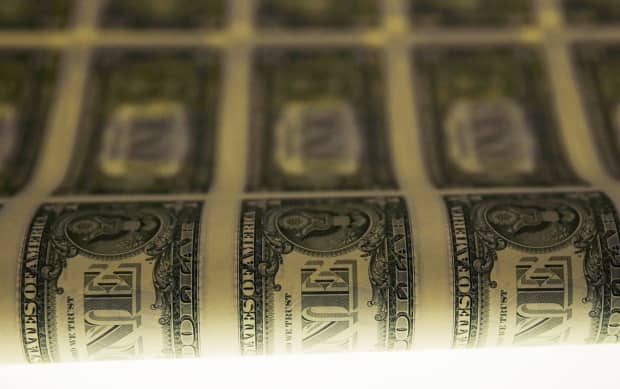
A sheet of one-dollar bills on a light table during production at the Bureau of Engraving and Printing in Washington.
Congress’s nonpartisan number crunchers said Monday that the government would have to make major cutbacks in spending or raise taxes sharply — to the tune of hundreds of billions of dollars — to keep already-high debt levels from growing further.
The Congressional Budget Office’s annual long-term budget outlook showed some of the impact the coronavirus pandemic and bills aimed at easing its economic fallout. In short, the country’s debt-filled future looks to be in danger of becoming only more so.
“CBO now projects that debt as a percentage of GDP will be 45 percentage points higher in 2049 than the agency projected last year. Larger projected deficits in 2020 and 2021 contribute significantly to that difference. The increase in those deficits results primarily from the effects of the pandemic and actions taken to respond to it,” the agency said.
The debt-to-GDP level, a measure economists say gives a better idea of the debt burden than nominal dollars levels, is set to reach 98% of GDP this year, rise to a record 107% in 2023 before rising to 195% in 2050.
All of that raises the risks of a financial crisis, the CBO said, though it said that risk was not reflected in financial markets SPX,
Opinion: Ballooning federal deficits threaten Fed independence, and give an opening to Chinese yuan, writes Peter Morici
“Concerns about the government’s fiscal position could lead to a sudden and potentially spiraling increase in people’s expectations of inflation, a large drop in the value of the dollar, or a loss of confidence in the government’s ability or commitment to repay its debt in full,” CBO said.
If lawmakers wanted to keep debt stable, a less ambitious goal than reducing it to where it was before pandemic or to the 35%-to-GDP level of 2007, before the financial crisis, the required deficit reduction would be substantial.
The CBO said just keeping the debt stable at 100%-to-GDP in 2050 would require deficit reduction — through tax hikes, spending cuts or a mix of the two — equivalent to 2.9% of GDP in 2025.
“In 2025, 2.9 percent of GDP would be about $730 billion, or $2,200 per person. If such an adjustment was made in 2025 and each year thereafter, the budget would show a primary deficit of 1.9 percent of GDP in 2030 and 4.7 percent of GDP by 2050,” CBO said.
For the sake of comparison, $730 billion is slightly less than what lawmakers are expected to authorize for the Defense Department and related nuclear-weapons programs for the upcoming budget year starting Oct. 1.
tinyurlis.gdu.nuclck.ruulvis.netshrtco.de
مقالات مشابه
- UFC را سختگیرانه تر coronavirus تست پروتکل های لاس وگاس کارت
- لیگ برتر بازگشت خواهد 'بالابر ارواح ملت' و انگلستان Raab می گوید: — اما می توانید آن را به کار?
- Drew Brees' عذرخواهی حلقه توخالی برای برخی از ورزشکاران
- غنی در حال گرفتن غنی تر میان عملکرد بالا ETFs هم
- مایکل Conforto را متس آینده می تواند تغییر را با توجه به کروناویروس بحران
- شد مایکل جردن را قمار مشکل ؟ "آخرین رقص' به کنکاش بدنام طرف MJ
- پیستون موتور چیست ؟
- شیر فشار شکن چگونه کار می کند؟
- شرکت صادرات و واردات کالاهای مختلف از جمله کاشی و سرامیک و ارائه دهنده خدمات ترانزیت و بارگیری دریایی و ریلی و ترخیص کالا برای کشورهای مختلف از جمله روسیه و کشورهای حوزه cis و سایر نقاط جهان - بازرگانی علی قانعی
- بهترین انواع ضبط ماشین بلوتوث دار و پخش خودرو فلش خور - بیک نیک